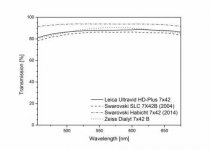I've rather been enjoying the cut-and-thrust of the various opinions on testing methods, quality control, lighting environment and sample variation etc. above. From the perspective of the guy in the 4th row with his hand up wanting to ask a question or two, these are what would occur to me (taking as a given that the testing conditions for transmission are constant for the models to be compared and that the chosen light doesn't skew results for particular approaches to lens design):
1. At what level of difference in measurement across the colour transmission range would this become a noticeable factor for the user?
2. To what extent is what could be seen as a 'flaw' actually be a product of design? (the famous 'Zeiss vs Swarovski' approach to blue wavelengths, for example)
3. Would the world's perfect binocular (should it exist) be flat across the whole colour range, or would - given the difference in colour temperature in which we bird across the globe and the number of different eyes we collectively possess - only lead to other problems?
From my own point of view, i see a difference in my two main bins (Zeiss FL 8x32 and Vanguard EDII 8x42) in regard to colour reproduction, but can't fault either when it comes to birding.
Just a few thoughts, based on the interface of exact science's interface with a very inconsistent species and the environment in which it disports itself!
1. At what level of difference in measurement across the colour transmission range would this become a noticeable factor for the user?
2. To what extent is what could be seen as a 'flaw' actually be a product of design? (the famous 'Zeiss vs Swarovski' approach to blue wavelengths, for example)
3. Would the world's perfect binocular (should it exist) be flat across the whole colour range, or would - given the difference in colour temperature in which we bird across the globe and the number of different eyes we collectively possess - only lead to other problems?
From my own point of view, i see a difference in my two main bins (Zeiss FL 8x32 and Vanguard EDII 8x42) in regard to colour reproduction, but can't fault either when it comes to birding.
Just a few thoughts, based on the interface of exact science's interface with a very inconsistent species and the environment in which it disports itself!






